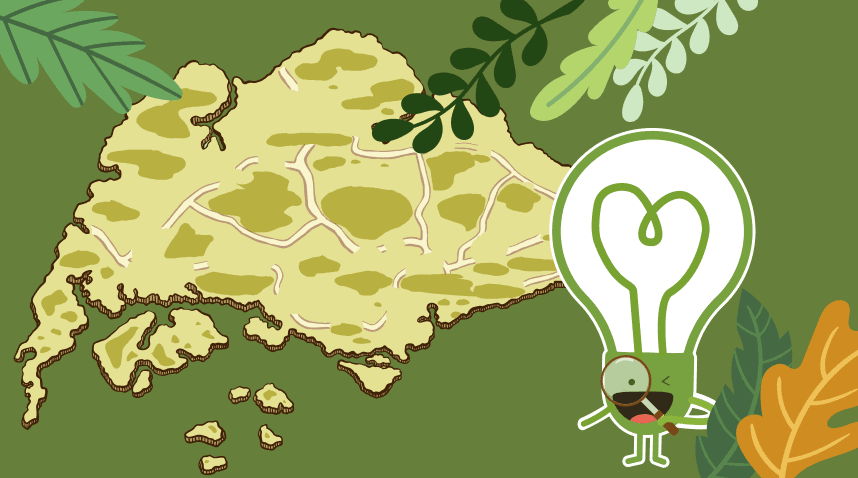TLDR: Nature is calling out to us. But are we ready for its gifts? Ophelia muses on the lessons of impermanence inspired by nature. She will walk you through her favourite forest-bathing treks in Singapore.
Have you ever noticed the birds chirp when you first open your eyes?
What about hearing cicadas sing as you pass by trees?
Do you remember those Circuit Breaker days when you can’t go anywhere but the parks? Since the borders have relaxed, we find our friends (or ourselves) heading out abroad for mountains, waterfalls, beaches and forests, as if nature has a certain magnetic pull. Why the allure?
Blue Light & Feeling Blue
These days, our awake moments are steep in constant scrolling, clicking, and typing on our devices. Blue light screams from LED screens. How do our minds grapple with what’s real and what’s not? Our bodies release dopamine from experiencing fleeting sensory bombardments within the virtual “aethers”.
Then, there’s the spinning of reports, rushing of deadlines, chasing numbers. All in the name of productivity and efficiency. Faster. Faster. Faster!
We get anxious. We get annoyed. We get angry.
Harbouring this agitation, we turn towards self-help articles, Netflix, e- gaming and infinite scrolling. None of them seems to cut it. They can’t hit the scratch of calm. The affliction spirals deeper.
Couple the digital dizziness with an overcrowded “air-conditioned nation” and mask-wearing: we need fresh air, literally.
We need a break. Nature’s calling.
Pause. Listen.
Let your eyes rest on the greens, browns and blues.
Let the breeze caress your weary face.
Collectively, we need to slow down and find our grounds, such that the next wave of mind-bending circumstance or emotion doesn’t crash our sanity. Together, we can heal with resilience. Nature has been teaching us how.
Stepping into a forest, we can leave our worries and anxiety at its fringe. The hike leads us to a simple earthly presence. An awareness of what’s around us, of our breathing. Our senses sharpen and so does our observation.
Immediately, nature’s beauty impresses upon us. It lures our thinking mind out to bodily sensations. We feel nature in the sweats of our skin. We hear the leaves rustle with the cooling breeze against our faces. We smell nature from the damp undergrowth. We see green shades and organic shadows, simply existing against the blue skies.
In nature, we are overwhelmed by the solace and solitude wilderness brings, albeit temporarily. We start to notice what moves: insects, unexpected guests like wild boar, monkeys, welcoming birdsongs, and fluttering butterflies. Each organism’s mere existence relies on and supports other organisms.
Soon enough, the mind tunes into a quiet existential background beneath all the cacophony: the sheer fabric of awareness that recognises we are all alone collectively, our interdependent co-existence.
Part of a greater flow we can’t force nor stop
Nature teaches us to grow with the right conditions. There are some things we can’t force. Having been scattered away from its parent, saplings germinate when sunlight pierces through a clearing in the forest canopy. They grow taller with torrential rain but we can’t yank them taller. Flowers bloom only with the season’s liking. Fruits only get born after the right pollinators fertilise their flowers. Vines climb up where branches hang.
Just like humans, each plant species has its season and time zone. When given the right amount of sunlight, water and nutrition, can the plant grow. Apart from ensuring that the conditions are met, we leave the rest to let nature run its course. We learn the pace of nature, patience, and not rushing into wanting the tree to grow overnight.
Nature shows us that there are some things we can’t stop either. Flowers wilt. Leaves brown and fall. Even the sturdiest hardwood falls after an unfortunate lightning strike. Streams flow from higher grounds to lower levels. Tropical thunderstorms pour whenever the clouds are too heavy. Much as we hate deterioration and want to stop it from happening so badly in nature, we can’t.
This cycle of impermanence whirls on, turning what we thought was beautiful into the unbeautiful.
Yet a dead log and the leaf litter form the fertile ground for fungi to emerge from, for the next sapling to nestle in. What gives way to death, gives way to growth. This circular economy within the forest is a mere microcosm of what’s happening in our urban modern city.
When we observe Nature, we can look inwards better. After all, we are part of Nature ourselves. Earth, wind, water and heat – the four elements of nature return to dust, just as all living beings. In the forest, when the cycle of life and death is littered in every step of our way, every sight we see… we learn to be detached, to see things as they really are, to let go of wanting and not-wanting.
Where can we experience our natural “self”?

With the benefits of ‘natural remedy’ in mind, below are a few parks I have personally trekked, not in any particular order:
1. Singapore Botanical Gardens
If you fancy prim and proper paths with a trimmed landscape, the Evolution Garden in the Singapore Botanical Gardens transports you back in time (NParks’ guide) while the Rain Forest trail introduces a slice of our tropical primary jungle to you without getting your shoes muddy.
Perfect for a stroll with your loved ones, especially if you want to pepper the walk with heart-to-heart talk. Most paths in the Gardens are barrier-free.
Who knew Singapore had such alien-looking trees? Evolution Garden, Singapore Botanic Gardens (Photo Credit: Wikimedia Commons)
2. MacRitchie Reservoir
For an authentic forest bathing experience, the raw, exposed, and sometimes peaty treks across Singapore’s nature reserves invite your soles to kiss its earth gently. Challenge your stamina by hiking from MacRitchie Reservoir to Bukit Timah summit, cutting through Central Catchment Reserve from Chestnut Park to Mandai (drop by a pumping station for a water view), or along the northern stretch of Rail Corridor (Kranji to Bukit Panjang).
Get ready for complete immersion: jungle hat, hiking shoes, dry-fit attire, sunblock, a neat bottle for hydration, and poncho/umbrella if the weather is unkind. Some altitude is expected. What fun is there if the journey is all flat and smooth?
3. Pasir Ris Park & The islands
Fifty shades of green too much to digest? No worries. There are equally scenic routes for restless adventurers, whose attention spans are more engaged with a geographical variation. Fortunately, there remain in Singapore a few of these 3-in-1 natural sanctuaries (forest, mangroves, coastline).
Forget the overrated Coney Island. Try its neighbouring Pasir Ris Park, which is famous amongst birdwatchers. If you have an entire day to spend, why not head down to Lazarus Island and St John Island via scheduled ferry? Pack your swimsuits to complete your day-cation.
4. Bukit Brown Cemetery
Rounding off the list, we introduce the ultimate forest experience in the Bukit Brown Cemetery. Obviously not for the faint-hearted. Top off the bucket list with death-contemplation meditation (read these links here and here for greater details).
[Warning: Do explore the area in groups, especially after daylight.]
After all these recommendations, jio (invite) your family and friends to dip into the cool shade of Singapore’s forest canopy while it still stands.
For in this land-scarce country, the concrete jungle is taking over our lush natural heritage as our days go unnoticed. When that time comes, perhaps that’s the final lesson of letting go that nature can give us.
Wise Steps:
- Commit a morning and pick a park! Be on your feet – get ready to explore and to discover solo or with a like-minded company;
- In nature, notice the sensory contacts – what you see, hear, smell, touch – what is going through your mind?
- If there is a quiet spot in nature, meditate on your breathing. Be aware of how inner and external chatter gets in the way of appreciating the gifts nature offers us.
- Have fun along the way! Know your Tree and spot the different trees familiar in our Garden City. Learn bird calls as you tune into nature’s ‘symphony FM92.4.’


